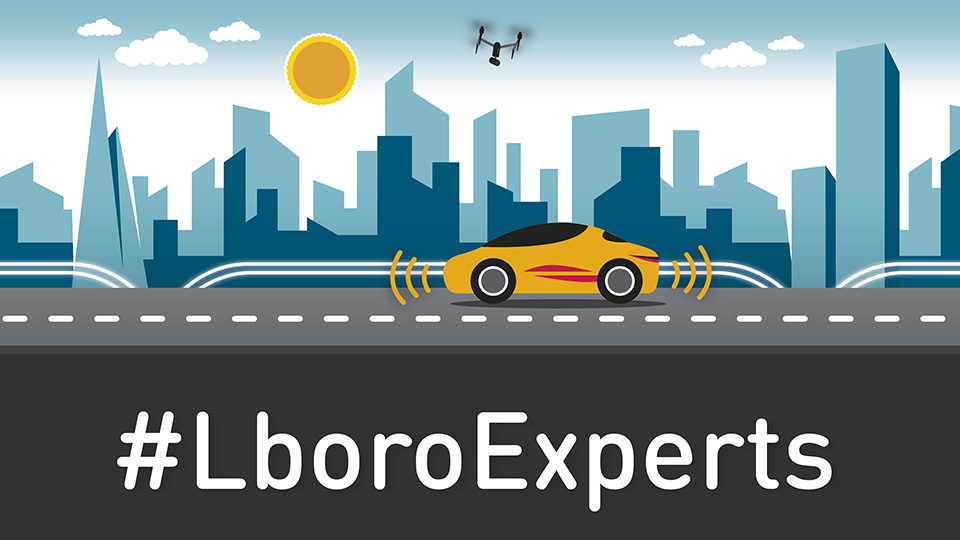15 Jan 2020
Video Q&A: We asked an expert panel your questions on the future of transport
 Part of Loughborough's Future Transport campaign.
Part of Loughborough's Future Transport campaign.
What will our cars look like if they become fully autonomous? What’s the likelihood of vehicle-to-grid being successful? Will flying cars be safe? Or will they present new dangers?
Part of Loughborough's Future Transport campaign.
Ponder no more as we have asked some of your weird and wonderful questions on the future of transport to a panel of #LboroExperts from different research backgrounds.
Professor Andrew Morris, Professor Martin Passmore, Professor Jin Xuan, Dr Tracy Ross and Dr Ashleigh Filtness have shared their thoughts on how we may be travelling in the decades to come.
We’ve included some of our favourite Q&As below and a video of the full interview above – it covers everything from time travel to train delays!

How safe are driverless cars?
“A very good question as, at the moment, we simply don’t know the answer and that’s why we’re doing a lot of research in this area", said Professor Morris, an expert in Human Factors in Transport Safety.
“We think on the whole they will be pretty safe and the evidence in laboratory tests and on test tracks suggests there’s a high degree of safety associated with these vehicles.
“But if you look at what’s happening with things like Waymo cars (the Google cars driving around North America) you find they have only logged around 100 million miles and really you need about three times that amount of travel in a fleet of 100 vehicles with no accidents at all to be confident the vehicles are entirely safe."

There are safety challenges to overcome with driverless vehicles, say experts. Image courtesy of Getty Images.
He continued: “Having said that, we have some anecdotal cases involving driverless cars and pedestrians and cyclists, where they’re not really tuned into the scenarios that those particular traffic situations present and that’s a bit of a worry for us.
“If the vehicles can’t detect the presence of cyclists and pedestrians and other road users satisfactorily, then there’s some safety challenges that we’re yet to overcome.”
Will drink drivers become a thing of the past with new technology?
“There is already technology available to help with drink driving problems”, said Dr Filtness, whose research area is Transport Safety.
“We have an interlock, which is a breathalyser you can put into the vehicle and the ignition won’t start if it has a reading for alcohol.
“These are becoming more common, for example, they’re regularly used in Sweden on public transport.
“So public transport drivers are required to give a breathalyser reading and the vehicle won’t start if they’re shown positive for alcohol.
“I think that level of technology could be widely rolled out and available in cars.”
How do you expect the shape of cars and other vehicles to change over time?
Professor Passmore, an expert in Automotive Aerodynamics, said: “It’s quite hard to predict as vehicle shape is often a design and style-driven thing, but if we’re going to reduce drag and move to electric, it is possible to package it differently."

The shape of our cars and the technology they're equipped with may be set to change, say experts. Image courtesy of Getty Images.
He explained: "You may not need an engine, and this could present the opportunity to make cars slightly lower and reduce the aerodynamic drag.
“We can optimise them differently and of course the other thing we can do in the future is make cars a bit smaller as this has a big impact on the amount of energy we consume.”
Questions featured in the Ask An Expert video were submitted by students and members of the public via Loughborough University’s Instagram page.
Additional information:
Professor Andrew Morris has also featured in The Conversation answering questions on the future of transport. You can read the article here and watch the videos that accompany the piece in this playlist.
And if you're interested in the development of autonomous vehicles, check out this press release on Dr Varuna De-Silva's latest project, which involves developing AI systems that can think and respond to complicated environments – like road junctions – much faster than any human is able to.











